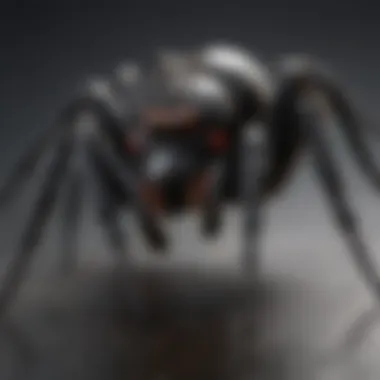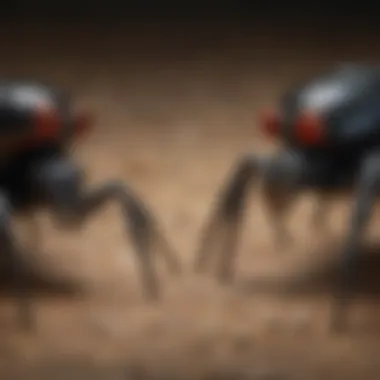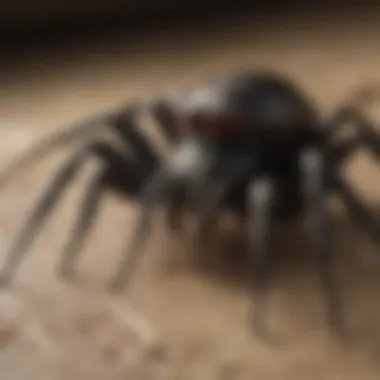Understanding Black Widow Pests: Risks and Control


Intro
Understanding the black widow spider is crucial. This pest poses not just a physical threat but also psychological discomfort to many homeowners and residents. Knowledge about their identification, risks involved, and effective control measures is essential in ensuring safety in various living environments. This article provides a detailed exploration of these aspects, serving as a practical guide for housewives, house owners, and pest control professionals alike.
Pest Identification
Identifying black widow spiders is the first step in managing their presence. These spiders are recognizable by their glossy black bodies and the distinctive red hourglass marking on the underside of their abdomens. Adult females are larger than males, typically measuring about 1.5 inches including leg span.
Detailed descriptions of common pests
- Female Black Widow: The iconic shape and color make it easy to identify. They tend to make their webs in secluded areas, such as under furniture, in basements, or sheds.
- Male Black Widow: Smaller and less potent than females, they have a more varied coloration, which can include stripes. These spiders are often overlooked due to their unassuming appearance.
- Juvenile Black Widows: Young spiders may not display the characteristic markings clearly, making it challenging to identify them correctly.
Signs and symptoms of infestations
Household signs of a black widow problem include:
- Presence of irregular webs with a sticky texture in corners or crevices.
- Actual sightings of the spider, primarily during the evening as they are nocturnal.
- Sudden numbers of insects in or outside the home, indicating availability of food sources, which may attract these spiders.
“It’s critical for any homeowner to learn how to identify these pests, as prevention starts with awareness.”
Prevention Strategies
Once identified, attention should turn to prevention strategies. Effective measures can significantly reduce the risk of infestations.
Home maintenance tips for pest prevention
- Regular Cleaning: Frequent vacuuming and dusting remove potential hiding spots and food sources.
- Seal Cracks: Inspect the home for cracks and gaps, then seal them properly to limit entry points.
- Outdoor Maintenance: Keep gutters clean and trim shrubs; this reduces the places where spiders can build webs and hide.
Natural deterrents and barriers
There are various environmentally friendly options to discourage black widow spiders:
- Essential Oils: Oils like peppermint and tea tree can deter spiders when mixed with water and sprayed around the home.
- Diatomaceous Earth: This natural powder can be spread around potential entry points, acting as a barrier against many crawling pests, including spiders.
Treatment Options
Should an infestation occur, knowing treatment options is essential. Understanding the distinctions can inform effective management strategies.
Overview of chemical vs. natural treatments
- Chemical Treatments: Products like Raid Black Widow and Spider Killer can be effective, but they require careful application to ensure safety in homes with pets and children.
- Natural Treatments: Options like vinegar or soap solutions can be effective in repelling spiders without harmful chemicals. However, they may need to be reapplied regularly.
Step-by-step guides for DIY treatments
For those inclined to take a hands-on approach, DIY methods can help manage spider populations:
- Identify Problem Areas: Focus on corners, sheds, or garages where spiders are commonly found.
- Create a Spray Solution: Mix water with essential oils or vinegar in a spray bottle.
- Spray Regularly: Apply the solution to identified areas, especially after cleaning.
- Monitor Results: Keep an eye on the effectiveness of the solution and adjust as necessary.
Foreword to Black Widow Spiders
The study of black widow spiders is critical for understanding the risks they pose in various environments. Their identification, behavior, and potential health risks must be examined in detail. Homeowners should approach this topic with awareness, as these spiders are often found in residential areas. Knowledge not only aids in recognizing these pests, but also informs effective control strategies.
Defining Black Widow Spiders
Black widow spiders belong to the genus Latrodectus. They are known for their glossy black bodies and the distinctive red hourglass marking on the undersides of their abdomens. However, there are variations in color, so it is important to understand that not all exhibit this marking. Their size usually ranges from half an inch to one and a half inches in length. This wide range should heighten awareness among those who might encounter them in their homes or gardens. Notably, their venom is regarded as one of the most potent among spiders, which makes their correct identification significant.
Understanding the defining features of black widow spiders can empower individuals to respond properly if they are located nearby.
Historical Context of Black Widow Encounters


Historically, black widow spiders have been the subject of folklore and fear due to their venomous nature. Encounters have been documented for centuries, often linked with myth and exaggeration regarding their danger. In the 20th century, cases emerged where bites were reported as potentially lethal, underscoring the importance of both respect and caution concerning these creatures. Many communities have developed responses to infestations based on historical understanding and anecdotal experiences. Today, it remains pivotal for people to learn about these spiders not just to dispel myths, but to recognize their true threat and manage them effectively if necessary.
Understanding the historical context of black widow encounters can provide insights into societal fears and highlight the need for accurate education.
Through this exploration of black widows' defining features and historical contexts, the groundwork is laid for deeper engagement with their behaviors, health risks, and management strategies.
Identification of Black Widow Spiders
Identifying black widow spiders is crucial for effective pest management. Recognizing these spiders helps in mitigating risks associated with their presence. Homeowners and pest control professionals alike benefit from understanding how to identify black widows accurately. This knowledge leads to timely actions that ensure safety and prevention.
Physical Characteristics
Color Patterns
The color patterns of black widow spiders are significant for their identification. Typically, they exhibit a shiny black coloration. This key characteristic can draw attention and help in recognizing them quickly. The red hourglass marking on the abdomen is another unique feature that distinguishes them from other spiders. This distinct pattern plays a crucial role in informing a person of potential danger. However, it is essential to note that some individuals might have variations in this marking, which can create confusion.
Size Differentiation
Size differentiation is another important aspect when identifying black widow spiders. Adult females are generally larger than males. Females can reach up to 1.5 inches in body length, while males are about half that size. This size contrast aids in distinguishing between them. However, the smaller size of males can pose difficulties in identification. Knowing this difference is beneficial as it helps individuals assess the level of threat in their environment.
Distinctive Markings
Distinctive markings on black widow spiders provide critical clues for identification. The hourglass on the abdomen is not only striking but also a definitive feature. Variations exist, and some may present white or yellowish markings instead of red. These variations can influence how they are perceived. Recognizing these markings contributes to the overall aim of being informed about black widow spiders, enhancing safety measures and awareness for those living in affected areas.
Life Cycle and Development Stages
Understanding the life cycle and development stages of black widow spiders is vital for control strategies. Each stage presents unique opportunities for intervention and management. Knowledge of how these spiders mature aids homeowners and pest control professionals in addressing infestations effectively.
Eggs and Hatchlings
The eggs and hatchlings phase is the beginning stage of the black widow's life cycle. Female black widows can lay around 250 eggs at once, encased in a silk sac. Recognizing these egg sacs is crucial for effective control, as it can prevent the emergence of many spiderlings. This proactive measure can help manage populations before they become a larger issue.
Juvenile Stages
In the juvenile stage, young black widows resemble adults but are smaller. This phase lasts several months, during which they grow and mature. Identifying juvenile spiders can be challenging due to their size. However, understanding their growth patterns and behaviors can aid in monitoring and control efforts. Intervention during this stage can limit the chances of reaching maturity and contributing to the population.
Adult Maturity
Adult maturity marks the final stage of the black widow's life cycle. Reaching this stage, female black widows are capable of reproduction. Understanding this phase is critical as it is when they pose the most significant threat. Their capability to reproduce quickly can lead to increased populations. Recognizing signs of adult black widows empowers homeowners to take action and implement control measures effectively.
Habitat and Distribution
Understanding the habitat and distribution of black widow spiders is essential for effective pest management. These elements greatly influence the behavior and occurrence of these spiders in urban settings and natural habitats. Such knowledge helps homeowners and pest control professionals identify potential locations where black widow presence is likely and inform strategies to mitigate risks associated with their bites.
Natural Habitats
Preferred Environment
Black widow spiders thrive in warm, dry environments. They favor undisturbed areas such as woodpiles, sheds, and the nooks of garages. This preference is critical to their survival and reproductive success. The ability to hide away from both predators and environmental threats makes this habitat advantageous. The unique feature of their chosen environments is that they often include plenty of shelter but minimal disturbance from human activities. This characteristic often results in a higher likelihood of encounters in such spaces, making it very relevant for this article.
Common Regions
Black widow spiders are commonly found in various regions across North America, particularly in areas characterized by warmer climates. This range includes the southwestern United States, where the climate suits their environmental needs. The unique feature of these common regions is their seasonal variations that can lead to increased spider activity. During warm weather, black widows become more prevalent, posing greater risks to inhabitants. Understanding these common regions helps target control efforts effectively.
Human Influence on Habitat
Urban Encroachment
As urban areas expand, an increase in black widow sightings can be noted. Urban encroachment creates new habitats by providing areas where black widows can thrive, such as gardens and patios with ample debris. This shift in habitat is significant as it leads to more frequent interactions between humans and these spiders. The adaptability of black widows to urban landscapes makes cities an increasingly relevant context when discussing their management and risks.
Construction and Landscaping Impacts


Construction and landscaping play a major role in shaping the habitat of black widow spiders. Disrupting the natural environment through these activities can inadvertently create spaces that black widows exploit. Features like unused materials, overgrown vegetation, and the introduction of new structures can lead to increased spider populations. Recognizing the impacts of these actions is vital in addressing infestations and preventing potential health risks.
"Understanding black widow habitats and their adaptability can greatly inform prevention strategies."
In summary, examining the habitats and distributions of black widow spiders allows for better awareness and preparedness. Homeowners and pest control experts can design strategies to mitigate risks based on where these spiders are likely to dwell. This understanding serves as a cornerstone in managing encounters with black widow pests.
Behavioral Patterns
Understanding the behavioral patterns of black widow spiders is crucial for effective identification and management of these pests. Their behaviors can directly influence their risks to human health and the success of prevention strategies. By analyzing how black widow spiders feed and interact socially, homeowners can better tailor their control measures and reduce potential encounters.
Feeding Habits
Prey Preference
Black widow spiders exhibit a distinct prey preference, primarily targeting soft-bodied insects such as flies, beetles, and caterpillars. This preference is rooted in their need for an energy-rich diet. The selection of prey can significantly affect the local ecosystem's insect population, as the black widow plays a role in controlling these species. Knowing what attracts them to certain areas can guide effective prevention tactics. For instance, reducing the presence of common prey within the home can help minimize their attraction. However, their preference for specific insects can also become a double-edged sword; in ecosystems where black widows thrive, beneficial insects could be adversely affected.
Hunting Techniques
Black widow spiders use a combination of ambush and web-based hunting techniques. They typically create irregular cobwebs in secluded locations and wait for their prey to come close. Upon capturing their target, they inject venom to immobilize it before consumption. This method is efficient, as the webs allow them to catch prey without expending excessive energy. However, these hunting techniques also mean that control efforts must focus on disrupting their webs and eliminating hiding spots. Understanding these techniques can assist homeowners not just in prevention, but in actively managing any infestations.
Social Interactions
Solitary vs. Social Behavior
Black widow spiders are primarily solitary creatures, with minimal social interaction. This behavior significantly influences their reproduction and territoriality, as they tend to occupy well-defined areas, using their webs to claim territory. The solitary nature of these spiders can be beneficial in minimizing aggressive encounters with other organisms, including humans. This knowledge can help in identifying areas where they are likely to reside and therefore focus control measures in those specific regions. However, during mating season, males may venture near female spiders, creating a brief social interaction that carries risks for them, often resulting in predation by their mates.
Territoriality
Territoriality among black widow spiders is a key characteristic. They establish and guard their webs and feeding areas, which can often overlap with areas frequented by humans. This trait contributes to the potential for human encounters, especially in outdoor environments. Understanding their territorial behavior can help in identifying high-risk zones for bites. Homeowners should be mindful of regions around their properties that may support black widow habitation, such as wood piles, sheds, and dark corners. Taking preventive actions in these areas can lower the risk of encounters.
"By knowing the behavioral patterns of black widow spiders, you can create a safer home environment and effectively manage potential infestations."
In summary, behavioral patterns provide deep insight into the habits and risks associated with black widow spiders. A better understanding of their feeding habits and social interactions can lead to more informed decisions regarding prevention and control.
Health Risks Associated with Black Widow Spiders
Understanding the health risks posed by black widow spiders is vital for effective management and prevention strategies. Knowledge of these risks will help individuals identify potential hazards in their environments and respond appropriately. Bites from these spiders can be serious, leading to medical emergencies in some cases. Therefore, awareness surrounding their venom and the symptoms of bites is crucial for homeowners.
Venom and Its Effects
Chemical Composition
The venom of black widow spiders is primarily made of neurotoxins, which affect the nervous system. These toxins contain a variety of enzymes and proteins. One key characteristic that makes black widow venom particularly dangerous is the presence of alpha-latrotoxin. This toxin significantly impacts the host's ability to manage impulse signals sent from the nervous system. Understanding the chemical composition is essential, as it explains the severity of the symptoms exhibited during a bite.
The unique feature of this venom is its potent neurotoxic properties, making it a topic of interest in both medical and biological research. Its effects can vary greatly between individuals, influencing how quickly symptoms manifest and the intensity of the reaction.
Effects on Humans
The effects of black widow venom on humans can range from mild to severe. Initially, individuals may experience localized pain and swelling at the bite site. However, as the venom spreads, systemic symptoms can develop. A key characteristic of these effects is their sudden onset, which can include muscle cramps, abdominal pain, and elevated blood pressure. These symptoms are alarming and can lead to serious health complications if left untreated.
The unique aspect of how this venom affects humans highlights its potential for causing widespread discomfort and, in rare cases, life-threatening conditions. It is a reminder to take necessary precautions if a black widow is suspected in a particular area.
Symptoms of Bites
Identifying symptoms of black widow bites is crucial because early recognition can lead to immediate treatment. Common symptoms include sharp pain at the bite site, muscle spasms, and increased sweating. What makes these symptoms particularly concerning is their similarity to other health issues. This can sometimes delay appropriate interventions, making the identification process a significant focus of homeowner awareness.
One unique feature of the symptoms is that they can escalate quickly, requiring swift action from victims and those around them. Understanding these can save lives by prompting timely medical assistance.
Recognizing a Bite
Physical Symptoms


Physical symptoms of a black widow bite usually manifest rapidly. Initial signs often include redness and local swelling. A significant characteristic of these symptoms is the distinctive appearance of a two-pronged mark, which is typical for spider bites. Recognizing these unique indicators provides essential guidance to individuals when they suspect a bite occurred.
Furthermore, understanding these symptoms is beneficial for ensuring that medical help is sought promptly.
Recommended First Aid
Immediate care is needed following a suspected black widow bite. Recommended first aid practices include washing the bite area with soap and water and applying a cool compress to manage swelling. This practical aspect is vital, as it alleviates discomfort while waiting for professional medical treatment.
One unique feature of first aid measures is that they are usually straightforward and effective. Homeowners can confidently perform these steps, reinforcing the importance of knowledge in times of crisis.
Remember: Recognizing symptoms and responding quickly can reduce the complications that arise from a black widow bite.
Each of these health risks associated with black widow spiders outlines the necessity of awareness, recognizing symptoms, and appropriate responses.
Control Measures for Black Widow Infestations
Implementing control measures for black widow infestations is essential for several reasons. Firstly, these spiders pose health risks due to their venomous bites. Thus, effectively managing their presence ensures the safety of individuals and pets in homes. Additionally, control strategies help to maintain the aesthetics of the property, as spider webs can give an unkempt appearance. In this section, we will explore prevention tactics and treatment options that can aid in managing these pests effectively.
Prevention Tactics
Environmental Modifications
Environmental modifications are an important aspect of controlling black widow spiders. This approach targets changes in the habitat that can deter spiders from establishing themselves. Key modifications include removing clutter from outdoor spaces and sealing cracks and crevices on the exterior of buildings. Such alterations can reduce potential nesting sites, making it less favorable for black widows to thrive.
A significant advantage of environmental modifications is that it combines preventive actions with regular maintenance, lowering the chance of infestations before they can occur. For example, trimming bushes and keeping wood piles elevated can deter black widow activity. However, it requires continuous effort, and not all homeowners maintain these practices consistently.
Regular Maintenance
Regular maintenance is crucial in keeping black widow spiders at bay. This involves consistent cleaning and upkeep of outdoor areas. Basic yard work, such as mowing the lawn and cleaning gutters, diminishes potential spider habitats. Furthermore, inspecting basements and attics periodically can catch infestations at early stages.
The beneficial characteristic of regular maintenance is its comprehensive nature. It not only addresses potential spider harborage but also promotes overall property health. On the downside, this option may demand more time and effort from homeowners, which could cause lapses in routine maintenance.
Treatment Options
Natural Remedies
Natural remedies offer a more eco-friendly approach to black widow control. Common options include using diatomaceous earth or essential oils like peppermint and tea tree oil. These natural alternatives are appealing to many homeowners who prefer not to use synthetic chemicals. They contribute to pest management by creating an inhospitable environment for black widows without posing risks to humans or pets.
A unique advantage of natural remedies is their accessibility and low cost. Most can be found at local stores or made at home. However, they may not always be as effective as synthetic approaches. Thus, homeowners might see limited success if infestations are severe.
Chemical Solutions
Chemical solutions can be a powerful method for addressing black widow infestations effectively. Products containing pyrethroids or insect growth regulators can target adult spiders and disrupt their reproductive cycles. This method often yields quick results in reducing spider populations.
One key characteristic of chemical solutions is their potency and immediate effectiveness. For homeowners facing significant infestations, this strategy is often more successful than natural remedies. Nevertheless, these products can pose risks if not applied correctly. It is essential to follow instructions carefully and ensure that children and pets stay clear during treatments.
Effective control measures combine environmental modifications and regular maintenance with treatment options. This comprehensive strategy not only addresses existing infestations but prevents future ones as well.
Culmination
The conclusion serves as a pivotal segment of this article, bringing together the various elements discussed throughout. Understanding black widow spiders is essential not only for homeowners but also for pest control professionals. The information presented highlights the importance of proper identification, awareness of health risks, and effective control strategies. This reinforces a comprehensive approach to managing black widow infestations.
A key takeaway is the need for vigilance. By being informed, individuals can recognize the signs of black widow presence. This proactive mindset can lead to timely interventions, thus minimizing risks of bites and infestations.
Summarizing Key Takeaways
- Identification is crucial: Recognizing physical characteristics aids in accurate identification. Homeowners should familiarize themselves with the appearance of black widows, particularly the distinct markings.
- Health risks are real: Understanding the venom effects and symptoms associated with bites is vital for prompt action. Knowledge of first aid measures can greatly reduce the negative impacts of a bite.
- Control measures are effective: Implementing prevention tactics, such as environmental modifications and regular home maintenance, significantly reduces the chances of infestations. Both natural remedies and chemical solutions play important roles in treatment options.
Encouraging Proactive Monitoring
Engagement in regular observation of one's environment is crucial. Homeowners should routinely check areas where black widows may be present. This includes dark corners, garages, and sheds. Keeping a tidy environment discourages these spiders from making a home.
Furthermore, educating family members about recognizing these pests enhances overall safety. Knowledge within the household fosters a culture of awareness.
Consider scheduling seasonal inspections with pest control specialists. These professionals can assess risks and identify potential problems before they escalate. Being proactive in monitoring not only protects health but also peace of mind.
With an informed approach, homeowners can effectively manage black widow threats and ensure a safer living space.



